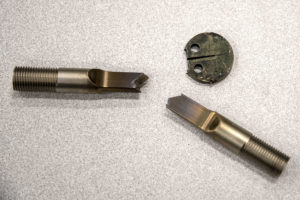Upwards, downwards or sideways. Quickly or slowly. Evenly or unevenly. New research at LiU shows how cracks propagate in gas turbine blades. The results may have far-reaching industrial implications.
Extreme stress
Just consider – a temperature of 500 °C and repeated loading corresponding to the weight of a truck. The blades in a gas turbine are subjected to huge stresses that lead to a long-term risk of them cracking. If this happens, they must be replaced. And the risk is real, despite the blades being manufactured from an extremely tough, and expensive, material – single-crystal nickel-based superalloys.
 In his doctoral thesis, Modelling of Crack Growth in Single-Crystal Nickel-Base Superalloys, Christian Busse has developed a model to calculate how cracks in the material propagate, with respect to both direction and speed. The way in which cracks grow may seem random, but it does, in fact, depend to a large extent on the properties of the material.
In his doctoral thesis, Modelling of Crack Growth in Single-Crystal Nickel-Base Superalloys, Christian Busse has developed a model to calculate how cracks in the material propagate, with respect to both direction and speed. The way in which cracks grow may seem random, but it does, in fact, depend to a large extent on the properties of the material.
It is, therefore, possible to calculate, and predict, how cracks propagate.
“The growth of cracks depends principally on how the single-crystal material has been cast. A crack does not propagate evenly: it can grow in several directions and at different speeds”, says Christian Busse.
“But you can’t completely disregard random effects, and I include these in my models.”
First time in 3D
The uneven crack propagation is a consequence of the material consisting of a single crystal with what are known as “anisotropic” properties (different properties in different directions). Previous models have considered only two dimensions, and have been based on two clearly defined modes of crack propagation – one perpendicular to the load, one determined by the crystal structure.
Christian Busse has for the first time managed to develop a 3D model that unites these two modes. This makes the calculations significantly more exact and – by extension – useful in practice. One important practical application will be to determine the service interval for a gas turbine.
“If you know how the crack will develop, it is not necessary to replace the component immediately the crack appears. It’s possible that the blade will function excellently for a long period, despite the crack”, says Christian Busse.
“This means that maintenance can be tailored, and that the safety margins, which are currently fixed using rather inexact methods, can be made more accurate. These components are expensive, and a better determination of maintenance needs will, not least, save money for gas turbine manufacturers.”
How different are your calculations from those currently in use?
“I don’t know exactly, and this is probably something that the manufacturers want to keep confidential. But I do know that the difference is so large that it’s worth them using the new model”, says Christian Busse.
The practical tests have been carried out in conditions similar to those of a gas turbine in operation, both in the laboratory at LiU and at a company in the US. Christian Busse himself, however, has spent most time in front of a computer screen, where he has created models based on the practical tests. An important task for future research will be to validate the model with further practical tests.
Source: LINKÖPING UNIVERSITY